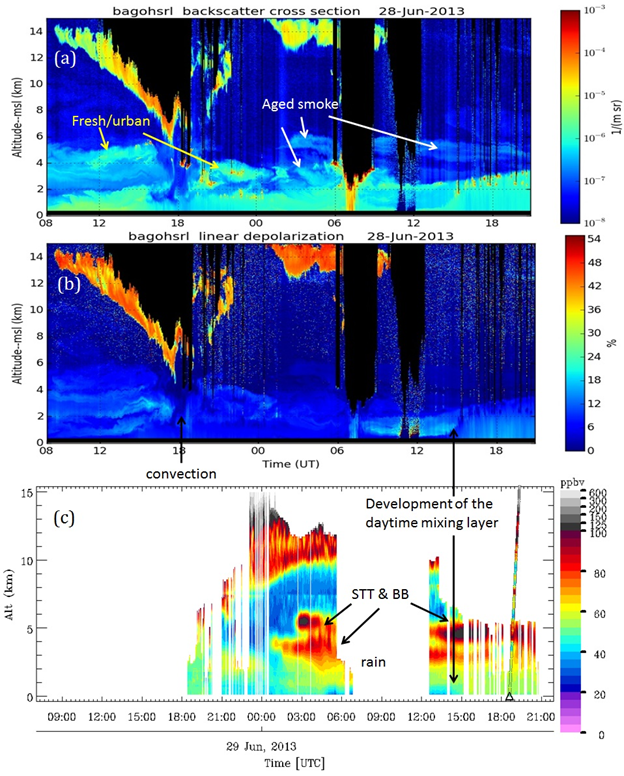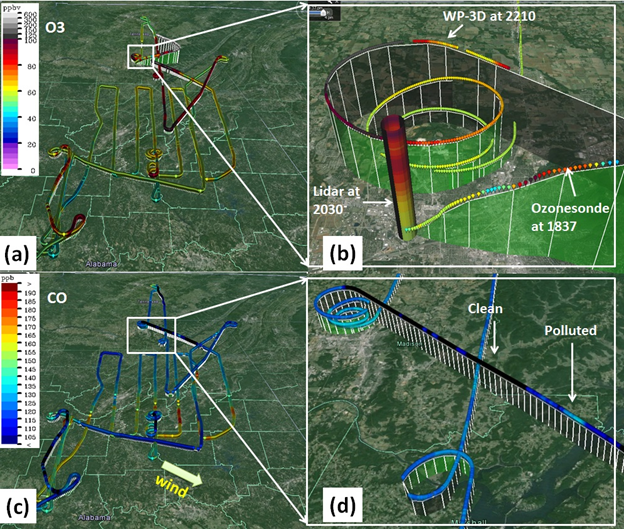FIELD CAMPAIGNS
An important mission of our instruments including lidar and ozonesonde is to support the field campaigns organized by federal agencies. Field campaigns conducted by multi-partners, usually constrained on a specific time and location, provide not only extensive, synergistic observations by instruments equipped at different platforms (e.g., ground-based, airborne) to investigate complicated atmospheric processes, but also an opportunity to intercompare the different types (e.g., in situ, remote sensing) of instruments to improve their measurement accuracies.
In 2013, two field campaigns, the Southeast Nexus (SENEX) (Warneke et al., 2016) and the Studies of Emissions and Atmospheric Composition, Clouds and Climate Coupling by Regional Surveys (SEAC4RS) (Toon et al., 2016), were conducted over the Southeastern United States (SEUS) covering a broad range of atmospheric chemistry and air quality science investigations. Figure 1 is an example showing coincident RO3QET lidar and University of Wisconsin HSRL aerosol observations at Huntsville, AL on 28-29 June 2013. The measurements reveal detailed O3 and aerosol structures associated with various processes, such as daytime convective mixing layer development, wildfire smoke transport, stratosphere-to-troposphere transport (STT), and cold frontal passage. The O3 below the front surface was significantly lower than that above. Two enhanced (+ 30 ppbv) O3 layers between 3 and 6 km behind the upper-air cold front were caused by both STT and fire smoke transport. The smoke was likely produced by the wild fires in western Canada as suggested by the HYSPLIT back-trajectory analysis. The STT process was driven by a tropopause fold near 40ON associated with an upper-air cutoff cyclone according to the PV analysis. Figure 2 shows the simultaneous ozonesonde, lidar, and NOAA's WP-3D airborne measurements (spiral diameter about 6 km) consistent with the analysis. The WP-3D measurements show a lot of correlated O3 and CO gradients in the PBL. However, O3 is not always correlated with CO because of O3's nature source, stratosphere. For more details, please read (Kuang et al., 2017).

Figure 1. Coincident O3 lidar and HSRL observations on 28 and 29 June 2013. (a) HSRL backscatter cross section; (b) HSRL linear depolarization; (c) O3 mixing ratios. The black triangle represents the collocated ozonesonde profile.

Figure 2. Ozonesonde, DIAL, and WP-3D measurements made in Huntsville on 29 June 2013 showing rapid O3 change above 3.4 km and unchanged O3 in the PBL. (a) O3, temperature, and RH measured by the ozonesonde launched at 1837 UTC and the simultaneous DIAL O3 profile. (b) The DIAL O3 profile at 2030 with a 10-min average. (c) The O3 and CO profiles measured by WP-3D at 2210.
REFERENCES
Kuang, S., M.J. Newchurch, M. S. Johnson, L. Wang, J. Burris, R. B. Pierce, E. W. Eloranta, I. B. Pollack, M. Graus, J. de Gouw, C. Warneke, T. B. Ryerson, M. Z. Markovic, J. S. Holloway, A. Pour-Biazar, G. Huang, X. Liu, and N. Feng (2017), Summertime tropospheric ozone enhancement associated with a cold front passage due to stratosphere-to-troposphere transport and biomass burning: Simultaneous ground-based lidar and airborne measurements, J. Geophys. Res. Atmos., 122(2), 1293-1311, doi:10.1002/2016JD026078.
Toon, O. B., et al. (2016), Planning, implementation, and scientific goals of the Studies of Emissions and Atmospheric Composition, Clouds and Climate Coupling by Regional Surveys (SEAC4RS) field mission, J. Geophys. Res. Atmos., 121, 4967-5009, doi:10.1002/2015JD024297.
Warneke, C., et al. (2016), Instrumentation and Measurement Strategy for the NOAA SENEX Aircraft Campaign as Part of the Southeast Atmosphere Study 2013, Atmos. Meas. Tech., 9(7), 3063-3093, doi:10.5194/amt-9-3063-2016. |